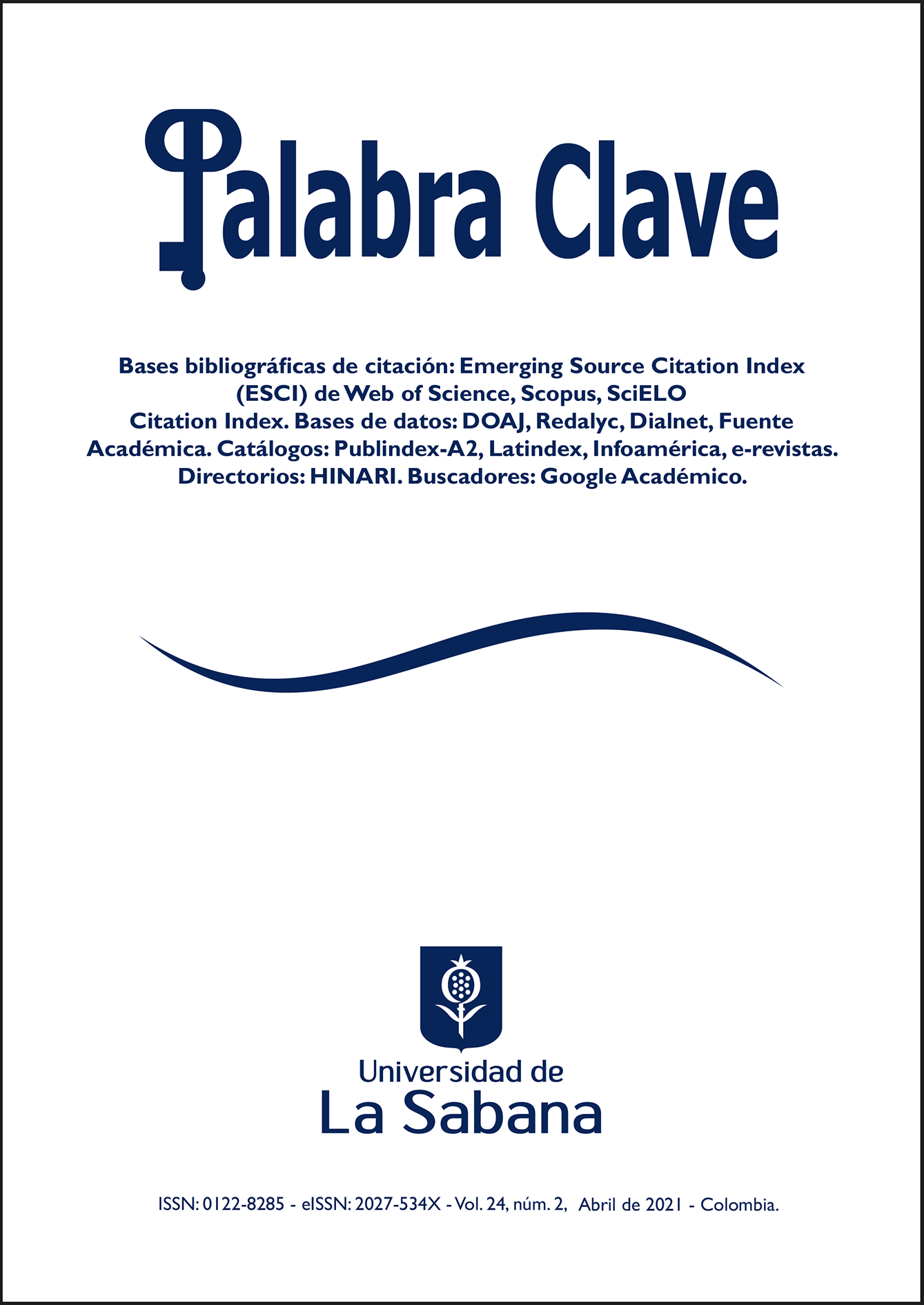El Mal Querer as a Visual Album: Spanish Symbology, Appropriation, and Transmedia Narrative in Rosalía’s Music Videos
DOI:
https://doi.org/10.5294/pacla.2021.24.2.6Keywords:
Cultural studies, mass media, popular music, speeches, aesthetics, pop music, disc recordings, records, musical performancesAbstract
Transmedia narrative entails a new configuration of cultural projects mediated by communication channels, combining traditional (television, radio, print media) and contemporary (online media, social media) ones. In them, the single management of messages is transcended and planned so that it makes sense through the media, and the timing of message delivery is diversified. As an heir to the conceptual rock album, the visual album establishes an extended music video format, whose prominent features are unity and coherence of the visual discourses. The article examines the visual motifs as recognizable symbols of the Spanish tradition and cultural appropriation by Rosalía’s visual album El Mal Querer (2018). The analysis is part of a reflection on the current music video and other well-known visual albums.
Downloads
References
CM Dance Studio (2019). Malamente–Rosalía/Yasmin Choreography. 11 de junio. Canal YouTube. https://www.youtube.com/watch?v=GZ_o_qDMuAs
Ball, K. (2016). Beyonce´s formation. Film Criticism, 40(3). DOI: http://dx.doi.org/10.3998/fc.13761232.0040.309
Bill RoXenos (2019). Rosalía - malamente (dance project) by bill roxenos. 17 de abril. Canal YouTube. https://www.youtube.com/watch?v=KlfgC_kn6to
Blanco Borelli, M. (2012). Dancing in music videos, or how i learned to dance like Jane... Miss Jackson. The International Journal of Screendance, 2, 52-55. Recuperado de: http://arts.brighton.ac.uk/projects/screendance/the-international-journal-of-screendance#page=60
BorjaRueda8 (2018). Rosalía–Malamente I Borja Rueda Choreography. 1 junio. Canal YouTube. https://www.youtube.com/watch?v=lB4nQQDmU5s
Broch, H. (1970). Kitsch, vanguardia y el arte por el arte. Barcelona: Tusquets.
Burns, L. A. (2016). The concept album as visual—sonic—textual spectacle: The Transmedial storyworld of Coldplay’s Mylo Xyloto. Ispmjournal, 6(2), 91-116. Consultado en: http://www.iaspmjournal.net/index.php/IASPM_Journal/article/view/783
Carrera, P., Limón, N., Herrero, E. y Sainz de Baranda, C. (2013). Transmedialidad y ecosistema digital. Historia y Comunicación Social, 18, 535-545. DOI: http://dx.doi.org/10.5209/rev_HICS.2013.v18.44257
Chandler, D. y Munday, R. (2011). Motif. A dictionary of media and communication. Oxford-Nueva York: Oxford University Press.
Corazón, A. (2018). Canada: “Rosalía ha desacralizado los símbolos, que es lo contrario de apropiárselos”. Jotdown. Consultado en: https://www.jotdown.es/2018/08/canada-rosalia-ha-desacralizado-los-simbolos-que-es-lo-contrario-de-apropiarselos/
Dixon, S. (2004). Digital performance: A history of new media in theater, dance, performance art and installation. Cambridge, MA: MIT Press.
Dodds, S. (2009). From Busby Berkeley to Madonna music video and popular dance. En J. Malnig (ed.), Ballroom, boogie, shimmy sham, shake: a social and popular dance reader. Chicago: University of Illinois Press.
Fairclough, K. (2018). Sountrack self: FKA twigs, music video and celebrity feminism. En G. Arnold, D. Cookney, K. Fairclough y M. N. Goddard (eds.), Music/video. histories, aesthetics, media (pp. 121-131). Salford: Bloomsbury Academic.
Frith, S. (1988). Music for pleasure. Essays in the sociology of pop. Cambridge: Cambridge University Press.
Genette, G. (1997). Paratexts: Thresholds of interpretation. Cambridge: Cambridge University Press.
Goodwin, A. (1992). Dancing in the distraction factory: Music televisión and popular culture. Minneapolis: University of Minnesota Press.
Guarinos-Galán, V. y Sedeño-Valdellós, A. (2018). Danza contemporánea y sincronía musicovisual en el videoclip musical actual. Revista Mediterránea de Comunicación, 9(2), 321-332. DOI: https://www.doi.org/10.14198/MEDCOM2018.9.2.3
Hansen, K. A. (2017). Empowered or objectified? Personal narrative and audiovisual aesthetics in Beyoncé’s partition. Popular Music& Society, 40(2), 164-180. DOI: https://doi.org/10.1080/03007766.2015.1104906
Harrison, C. (2014). The visual album as a hybrid art-form: A case study of traditional, personal, and allusive narratives in Beyoncé. [Master’s Thesis] Visual Culture, Department of Arts and Cultural Sciences, Lunds University, Lunds.
Hawkins, S. y Richardson, J. (2014). Remodeling Britney Spears: Matters of intoxication and mediation. Popular Music and Society, 30(5), 605-609. DOI: https://doi.org/10.1080/03007760600881359
Herman, D. (2009). Basic elements of narrative. West Sussex: Wiley-Blckwell.
Kleiler, D. y Moses, R. (1997). You stand there: making music video. Nueva York: Three Rivers Press.
Mairs Slee, S. (2017). Moving the music: Dance, action and embodied identities in music video. En G. Arnold, D. Cookney, K. Fairclough, M. N. Goddard (eds.), Music/video. Histories, aesthetics. Salford: Bloomsbury Academic.
Lacasse, S. (2000). Intertextuality and hypertextuality in recorded popular music. En M. Talbot (ed), The musical work: Reality or invention? (pp. 35-58). Liverpool: Liverpool University Press.
Leguizamón, J. A. (1998). Videoclips: una exploración en torno a su estructuración formal y funcionamiento sociocultural. [Tesis doctoral] Universidad Nacional de Santiago del Estero, Santiago del Estero. Consultado en: http://xurl.es/wwlwy
Letts, M. T. (2010). Radiohead and the resistant concept album: How to disappear completely. Bloomington: Indiana University Press.
Lizarazo Arias, D. (2004). Iconos, figuraciones, sueños. Hermenéutica de las imágenes. México: Siglo XXI.
Los Morancos Oficial (2018). Malamente–Rosalía | Los Morancos (Parodia). 20 de septiembre. Canal YouTube. https://www.youtube.com/watch?v=9L3dwNAsbxw&ab_channel=LOSMORANCOSOFICIAL
Perrott, L., Rogers, H. y Vernallis, C. (2016). Beyoncé’s Lemonade: She dreams in both worlds. Film International Online, 2. Recuperado de http://filmint.nu/?p=18413
Place (2019). Malamente | Rosalía - Choreography by Julie B. 12 marzo. Canal YouTube. https://www.youtube.com/watch?v=U90DhfGkoOg
Rodríguez-Mattalia, L. (2010). Videografía y arte: indagaciones sobre la imagen en movimiento. Castellón: Ars Universitat Jaume I.
Sedeño-Valdellós, A. M. (2016). El álbum visual como nueva forma promocional de la industria de la música: el caso de Let England Shake de PJ Harvey y Seamus Murphy. Palabra Clave, 19(1), 105-132. DOI: https://doi.org/10.5294/pacla.2016.19.1.5
Thomas, P. (2014). Single ladies, plural: Racism, scandal, and “authenticity” within the multiplication and circulation of online dance discourses. En M. Blanco Borelli (ed.), The Oxford Handbook of Dance and Popular Screen (pp. 289- 303). Nueva York: Oxford University Press.
Vernallis, C. (2008). Music video, songs, sound: Experience, technique and emotion in Eternal Sunshine of the Spotless Mind. Screen, 49(3), 277-297. DOI: https://doi.org/10.1093/screen/hjn036
Published
How to Cite
Issue
Section
License
Copyright (c) 2021 Palabra Clave

This work is licensed under a Creative Commons Attribution-ShareAlike 4.0 International License.
1. Proposed Policy for Journals That Offer Open Access
Authors who publish with this journal agree to the following terms:
- Authors retain copyright and grant the journal right of first publication with the work simultaneously licensed under a Creative Commons Attribution License that allows others to share the work with an acknowledgement of the work's authorship and initial publication in this journal.









